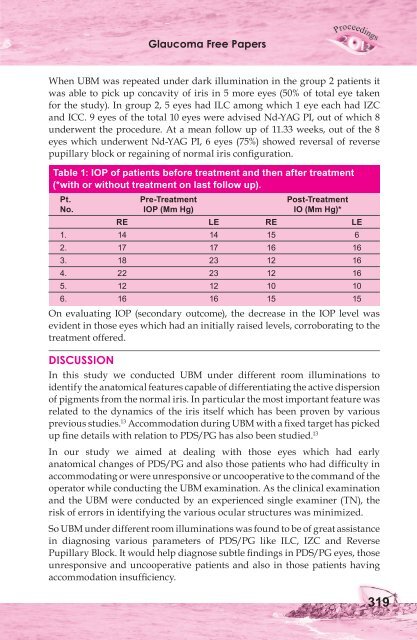Glaucoma-I Free Papers - aioseducation
Glaucoma-I Free Papers - aioseducation
Glaucoma-I Free Papers - aioseducation
Create successful ePaper yourself
Turn your PDF publications into a flip-book with our unique Google optimized e-Paper software.
<strong>Glaucoma</strong> <strong>Free</strong> <strong>Papers</strong>When UBM was repeated under dark illumination in the group 2 patients itwas able to pick up concavity of iris in 5 more eyes (50% of total eye takenfor the study). In group 2, 5 eyes had ILC among which 1 eye each had IZCand ICC. 9 eyes of the total 10 eyes were advised Nd-YAG PI, out of which 8underwent the procedure. At a mean follow up of 11.33 weeks, out of the 8eyes which underwent Nd-YAG PI, 6 eyes (75%) showed reversal of reversepupillary block or regaining of normal iris configuration.Table 1: IOP of patients before treatment and then after treatment(*with or without treatment on last follow up).Pt. Pre-Treatment Post-TreatmentNo. IOP (Mm Hg) IO (Mm Hg)*RE LE RE LE1. 14 14 15 62. 17 17 16 163. 18 23 12 164. 22 23 12 165. 12 12 10 106. 16 16 15 15On evaluating IOP (secondary outcome), the decrease in the IOP level wasevident in those eyes which had an initially raised levels, corroborating to thetreatment offered.DISCUSSIONIn this study we conducted UBM under different room illuminations toidentify the anatomical features capable of differentiating the active dispersionof pigments from the normal iris. In particular the most important feature wasrelated to the dynamics of the iris itself which has been proven by variousprevious studies. 13 Accommodation during UBM with a fixed target has pickedup fine details with relation to PDS/PG has also been studied. 13In our study we aimed at dealing with those eyes which had earlyanatomical changes of PDS/PG and also those patients who had difficulty inaccommodating or were unresponsive or uncooperative to the command of theoperator while conducting the UBM examination. As the clinical examinationand the UBM were conducted by an experienced single examiner (TN), therisk of errors in identifying the various ocular structures was minimized.So UBM under different room illuminations was found to be of great assistancein diagnosing various parameters of PDS/PG like ILC, IZC and ReversePupillary Block. It would help diagnose subtle findings in PDS/PG eyes, thoseunresponsive and uncooperative patients and also in those patients havingaccommodation insufficiency.319
















